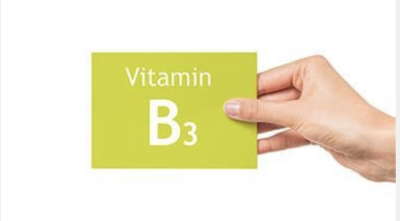Vitamin B3 Boosts Muscle Mass, Improves Glucose Control

All Global Research articles can be read in 51 languages by activating the Translate Website button below the author’s name (only available in desktop version).
To receive Global Research’s Daily Newsletter (selected articles), click here.
Click the share button above to email/forward this article to your friends and colleagues. Follow us on Instagram and Twitter and subscribe to our Telegram Channel. Feel free to repost and share widely Global Research articles.
Global Research Wants to Hear From You!
***
Getting enough vitamin B3 could help maintain muscle mass and strength as you age, while also helping control body fat and blood sugar levels
A study found consuming more niacin was linked to stronger hand grip, increased muscle mass and higher bone mineral content
People with higher niacin intake also had less body fat and a lower risk of losing muscle mass as they age
Niacin also helped with blood sugar control, showing benefits in reducing insulin resistance and keeping fasting blood sugar and insulin levels in check, especially in people without diabetes
For optimal health, I recommend taking 50 milligrams of niacinamide — one form of vitamin B3 — three times per day
*
Vitamin B3 comes in two primary forms: niacin, also known as nicotinic acid, and niacinamide (NAM), which is sometimes referred to as nicotinamide. Both forms of vitamin B3 are essential to human health and play important roles in cellular metabolism, converting the food you eat into energy.
These forms of vitamin B3 also serve as precursors for the coenzymes nicotinamide adenine dinucleotide (NAD+ ) and nicotinamide adenine dinucleotide phosphate (NADP), which are vital for energy production, DNA repair and cell signaling. Increasing your intake of vitamin B3 as you age may also be useful for supporting optimal health, with research showing it not only improves body composition but also glucose control.
Vitamin B3 Increases Muscle Mass, Decreases Fat and Improves Glucose Homeostasis
A study published in The Journal of Nutrition, Health and Aging suggests getting enough vitamin B3 in your diet could help maintain muscle mass and strength as you age, while also helping control body fat and blood sugar levels.1
The study involved people aged 40 and older, with researchers analyzing information from three data sets: one focusing on hand grip strength, with 3,772 participants, another on body composition like muscle and fat, with 3,279 participants, and a third on how the body handles glucose, or blood sugar, with 9,189 participants.
The scientists looked at niacin intake and other factors like physical activity and diet, then used various statistical methods to see how they related to muscle strength, muscle mass, fat levels, bone health, insulin resistance, blood sugar levels and the risk of losing muscle mass with age, or sarcopenia.
Consuming more niacin was linked to stronger hand grip, increased muscle mass and higher bone mineral content. People with higher niacin intake also had less body fat and a lower risk of losing muscle mass as they age. Further, niacin seemed to help with blood sugar control, showing benefits in reducing insulin resistance and keeping fasting blood sugar and insulin levels in check, especially in people without diabetes.
Vitamin B3 Increases NAD+ and NADP Levels, Leading to Significant Health Gains
One reason why vitamin B3 may be so useful as you age is due to its ability to increase NAD+ and NADP levels. As noted in the blog To Extract Knowledge From Matter, which is inspired by the work of the late Ray Peat:2
“The study is epidemiological and it did not distinguish between the various forms of vitamin B3 available through the diet or supplements. However, it was well-controlled and its findings match the known biochemical effects of vitamin B3, which the study authors cite themselves as the likely reasons for the observed results.
Namely, vitamin B3 increases NAD and NADP levels, which results in improved glucose metabolism as well as higher tissue anabolism (through NADP).”
NAD+ modulates energy production and many enzymes and in so doing controls hundreds of processes in your body including the survival of cells and energy metabolism. NAD+ is influenced on a daily basis by what you eat, exercise levels and more, and also declines with age, leading to changes in metabolism and an increased risk of disease.3
Boosting NAD+ levels may be akin to a fountain of youth, which is where vitamin B3 — as an NAD+ precursor — comes in. Supplementation with NAM has been found to improve insulin sensitivity in models of human diabetes, for instance, and it also decreases oxidative stress and prevents fatty liver.4
It also shows impressive promise for fighting obesity and associated diseases, including stroke, cardiovascular diseases, diabetes and certain cancers, which have reached epidemic levels worldwide.5
Writing in The Journal of Nutritional Biochemistry, researchers from Tsinghua University, Beijing, revealed that NAM reprograms adipose cellular metabolism and increases mitochondrial biogenesis to ameliorate obesity.6 In a study on obese mice, NAM supplementation led to significant reductions in fat mass and improved glucose tolerance, while increasing mitochondrial biogenesis in fat tissue.7
‘Striking’ Dose-Dependent Effects — But Only to a Point
The featured Journal of Nutrition, Health and Aging study found that niacin improves insulin resistance and glucose homeostasis at doses commonly consumed in the U.S. diet.8 However, it also revealed a strong dose-dependent effect. As reported by To Extract Knowledge From Matter:9
“Perhaps the most useful finding of the study was the striking dose-dependence of the effects it discovered — i.e., for every extra 1 mg/kg of weight of daily vitamin B3 consumed, a person lost 60 g of fat and gained 60 g of muscle. Oh, and if this was not already a spectacular result, the effects of vitamin B3 were the strongest in people with obesity (high BMI), hypertension, or advanced age — precisely the people who need benefits the most.”
The researchers pointed out that high doses of niacin may cause undesirable effects, including promoting insulin resistance. This is due to its dosage:10
“Some previous studies have suggested that niacin promotes insulin resistance, which is a significant side effect when niacin is used as a lipid-lowering drug. The reason for this inconsistent result lies in the dosage of niacin. When niacin is used as a lipid-lowering drug, its daily dose is 2-6 g, which far exceeds the daily dietary dose.”
To Extract Knowledge From Matter further explained:11
“Now, the study did have a cutoff in its vitamin B3 intake range. The maximum intake included in the study was about 238 mg daily. We don’t know if the benefits of vitamin B3 hold beyond those daily intake levels, but animal studies seem to suggest at least the metabolic benefits hold until at least a human-equivalent dose (HED) of 5mg/kg daily.
Since muscle and fat mass are largely a function of the metabolic rate, the study seems to suggest that an intake of vitamin B3 up to 5mg/kg daily may be even more beneficial.
The study does caution that when vitamin B3 is used as a lipid-lowering agent (i.e. in doses of 2g+ daily) negative effects and even reversal of the benefits may occur, so I’d suggest careful experimentation until the optimal daily dose is found, which will probably be different for each person.”
As I’ve explained in previous articles, however, too much niacinamide can backfire. A dose of just 50 milligrams (mg) three times per day will provide the fuel for nicotinamide phosphoribosyltransferase (NAMPT), the rate limiting enzyme for NAD+ . Nichola Conlon, Ph.D., a molecular biologist, antiaging specialist and founder of a nutraceutical company that produces an NAD+ boosting supplement, explained in our past interview:12
“The reason the salvage pathway declines with age is because of this one key enzyme. NAMPT actually recycles niacinamide and converts it into NMN [nicotinamide mononucleotide], which then gets converted back into NAD. The rate limiting step, the bottleneck in that process, is NAMPT. And lo and behold, that is the key enzyme that declines as we get older.
Studies have demonstrated that you get a 50% decrease in this enzyme between the ages of 45 and 60. That’s a significant decline considering how important this is for new NAD production. The decline in the levels of this enzyme again correlate with the decline in NAD that we experience.
Many diseases and issues that are associated with NAD decline are found to be because of a reduction in this enzyme. So, it’s absolutely critical to try and improve the activation and expression of this enzyme in the body to enhance NAD. It worked brilliantly to give us high NAD levels when we were younger, so why not restore it back to that?”
Tips for Vitamin B3 Intake
For optimal health, I recommend taking 50 mg of niacinamide three times per day. This dosage has been shown to optimize energy metabolism and boost NAD+ levels, which are foundational for everything else to work. It can be taken four times a day if you space them out. Take a dose as soon as you get up, another before going to bed, and two more evenly spaced between those times.
The problem with taking too much vitamin B3, whether in the form of niacin or niacinamide, is that it might backfire and contribute to cardiovascular disease as documented by the Cleveland Clinic.13Also, please note that although niacinamide and niacin are both forms of vitamin B3, niacin will not activate NAMPT like niacinamide, so it is best to use niacinamide. Additionally, niacinamide, unlike niacin, will not cause flushing, which is due to a large release of histamine.
It would also be helpful to make sure you’re getting all the other B vitamins, as they too are crucial for good health, including optimal mitochondrial function — especially regular niacin, riboflavin and folate. Decreased mitochondrial function is often due to a deficiency in B vitamins, and that’s easy to fix with a low-dose, high-quality B complex.
As for food sources, vitamin B3 is found in grass fed beef, mushrooms and avocados.14 Vitamin B6 is plentiful in grass fed beef, potatoes, bananas and avocados.15 You can find folate, or vitamin B9, in spinach, broccoli, avocado and asparagus.16 Vitamin B12-rich foods include grass fed beef liver, wild rainbow trout and wild sockeye salmon.
*
Note to readers: Please click the share button above. Follow us on Instagram and Twitter and subscribe to our Telegram Channel. Feel free to repost and share widely Global Research articles.
Notes
1, 8, 10 The Journal of Nutrition, Health and Aging September 2023, Volume 27, Issue 9, Pages 709-718
2, 9, 11 To Extract Knowledge From Matter February 23, 2024 (Archived)
3 Cell Metabolism, 28 Feb 2018, 27(3):529-547
4, 5 The Journal of Nutritional Biochemistry May 21, 2022, Introduction
6 The Journal of Nutritional Biochemistry May 21, 2022
7 The Journal of Nutritional Biochemistry May 21, 2022, Abstract
13 Nature Medicine February 19, 2024; 30: 424-434
14 My Food Data, Top 10 Foods Highest in Vitamin B3 (Niacin) April 25, 2024
15 My Food Data, Top 10 Foods Highest in Vitamin B6 April 25, 2024
16 My Food Data, Top 10 Foods Highest in Vitamin B9 (Folate) April 25, 2024
Featured image is from Mercola



